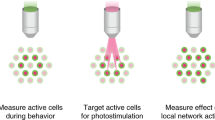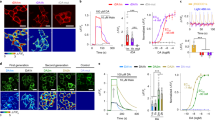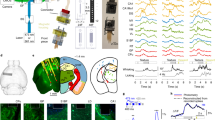Abstract
Recent advances in genetically encoded fluorescent sensors enable the monitoring of cellular events from genetically defined groups of neurons in vivo. In this protocol, we describe how to use a time-correlated single-photon counting (TCSPC)–based fiber optics system to measure the intensity, emission spectra and lifetime of fluorescent biosensors expressed in deep brain structures in freely moving mice. When combined with Cre-dependent selective expression of genetically encoded Ca2+ indicators (GECIs), this system can be used to measure the average neural activity from a specific population of cells in mice performing complex behavioral tasks. As an example, we used viral expression of GCaMPs in striatal projection neurons (SPNs) and recorded the fluorescence changes associated with calcium spikes from mice performing a lever-pressing operant task. The whole procedure, consisting of virus injection, behavior training and optical recording, takes 3–4 weeks to complete. With minor adaptations, this protocol can also be applied to recording cellular events from other cell types in deep brain regions, such as dopaminergic neurons in the ventral tegmental area. The simultaneously recorded fluorescence signals and behavior events can be used to explore the relationship between the neural activity of specific brain circuits and behavior.
This is a preview of subscription content, access via your institution
Access options
Subscribe to this journal
Receive 12 print issues and online access
$259.00 per year
only $21.58 per issue
Buy this article
- Purchase on Springer Link
- Instant access to full article PDF
Prices may be subject to local taxes which are calculated during checkout







Similar content being viewed by others
References
Looger, L.L. & Griesbeck, O. Genetically encoded neural activity indicators. Curr. Opin. Neurobiol. 22, 18–23 (2012).
Kerr, J.N. & Denk, W. Imaging in vivo: watching the brain in action. Nat. Rev. Neurosci. 9, 195–205 (2008).
Ghosh, K.K. et al. Miniaturized integration of a fluorescence microscope. Nat. Methods 8, 871–878 (2011).
Cui, G. et al. Concurrent activation of striatal direct and indirect pathways during action initiation. Nature 494, 238–242 (2013).
Wang, K.H. et al. In vivo two-photon imaging reveals a role of arc in enhancing orientation specificity in visual cortex. Cell 126, 389–402 (2006).
Lleres, D., Swift, S. & Lamond, A.I. Detecting protein-protein interactions in vivo with FRET using multiphoton fluorescence lifetime imaging microscopy (FLIM). Curr. Protoc. Cytometry 12, 12.10 (2007).
Kettling, U., Koltermann, A., Schwille, P. & Eigen, M. Real-time enzyme kinetics monitored by dual-color fluorescence cross-correlation spectroscopy. Proc. Natl. Acad. Sci. USA 95, 1416–1420 (1998).
Gong, Y., Li, J.Z. & Schnitzer, M.J. Enhanced archaerhodopsin fluorescent protein voltage indicators. PLoS ONE 8, e66959 (2013).
Grimley, J.S. et al. Visualization of synaptic inhibition with an optogenetic sensor developed by cell-free protein engineering automation. J. Neurosci. 33, 16297–16309 (2013).
Vogel, S.S., Blank, P.S., Koushik, S.V. & Thaler, C. in Laboratory Techniques in Biochemistry and Molecular Biology Vol. 33 (ed. Gadella, T.W.J.) 351–394 (Elsevier, 2009).
Elangovan, M., Day, R.N. & Periasamy, A. Nanosecond fluorescence resonance energy transfer-fluorescence lifetime imaging microscopy to localize the protein interactions in a single living cell. J. Microsc. 205, 3–14 (2002).
Klarenbeek, J.B., Goedhart, J., Hink, M.A., Gadella, T.W. & Jalink, K. A mTurquoise-based cAMP sensor for both FLIM and ratiometric read-out has improved dynamic range. PLoS ONE 6, e19170 (2011).
Harvey, C.D., Yasuda, R., Zhong, H. & Svoboda, K. The spread of Ras activity triggered by activation of a single dendritic spine. Science 321, 136–140 (2008).
Hoffmann, C. et al. A FlAsH-based FRET approach to determine G protein–coupled receptor activation in living cells. Nat. Methods 2, 171–176 (2005).
Dombeck, D.A., Harvey, C.D., Tian, L., Looger, L.L. & Tank, D.W. Functional imaging of hippocampal place cells at cellular resolution during virtual navigation. Nat. Neurosci 13, 1433–1440 (2010).
Yelin, D., Bouma, B.E., Yun, S.H. & Tearney, G.J. Double-clad fiber for endoscopy. Optics Lett. 29, 2408–2410 (2004).
Dunn, R.C. Near-field scanning optical microscopy. Chem. Rev. 99, 2891–2928 (1999).
Gong, S. et al. Targeting Cre recombinase to specific neuron populations with bacterial artificial chromosome constructs. J. Neurosci. 27, 9817–9823 (2007).
Chen, T.W. et al. Ultrasensitive fluorescent proteins for imaging neuronal activity. Nature 499, 295–300 (2013).
Akerboom, J. et al. Optimization of a GCaMP calcium indicator for neural activity imaging. J. Neurosci. 32, 13819–13840 (2012).
Acknowledgements
We thank V. Jayaraman, R.A. Kerr, D.S. Kim, L.L. Looger, and K. Svoboda from the GENIE Project, Janelia Farm Research Campus, Howard Hughes Medical Institute for allowing us to use GCaMP6s vectors. We thank L.L. Looger, J. Akerboom and D.S. Kim from the GENIE Project, Janelia Farm Research Campus, Howard Hughes Medical Institute for permission to use GCaMP5G vectors; L.L. Looger and Janelia Farm Research Campus of the Howard Hughes Medical Institute for permission to use GCaMP3 vectors; C.R. Gerfen for gifts of multiple bacterial artificial chromosome transgenic mouse lines; and K. Jalink for gifts of DNA constructs of EPAC (exchange proteins directly activated by cAMP) sensors. This work was supported by US government funding from the Division of Intramural Clinical and Biological Research of the National Institute on Alcohol Abuse and Alcoholism to D.M.L., S.S.V. and R.M.C., by the European Research Council (STG 243393), and by an International Early Career Scientist grant from the Howard Hughes Medical Institute to R.M.C.; by a National Research Foundation of Korea grant (2011-0029485, 2012-0004003) and a Smart IT Convergence System Research Center grant (SIRC-2011-0031866) from the Korean government (MEST) to S.B.J.; and by an Ellison Medical Foundation grant (AG-NS-0944-12) to X.J.
Author information
Authors and Affiliations
Contributions
R.M.C. and S.S.V. conceived the original idea of using the TCSPC technique for optical equipment, and optimized procedures for in vivo optical recording. G.C. and S.B.J. carried out the in vivo experiments and analyzed data. X.J. helped with programming and data analysis. G.L. performed the DNA transfection in HEK cells and helped in maintaining mouse lines. M.D.P. performed initial in vitro experiments by using the TCSPC system and analyzed data. G.C., D.M.L., S.S.V. and R.M.C. wrote the paper.
Corresponding authors
Ethics declarations
Competing interests
The authors declare no competing financial interests.
Integrated supplementary information
Supplementary Figure 1 An alternative design of the optical pathway using a single fiber probe to convey excitation laser light and collect emitted photons.
1. AR-coated multimode fibre cable with 2 SMA connectors (e.g. Thorlabs cat. no. M200L02S-A). 2. Fibre coupler for SMA connectors (e.g.Thorlabs cat.no. PAF-SMA-11-A). 3. Fibre coupler adapter with threaded central bore for C mount (e.g. Thorlabs cat. no. HCL). 4. Adapter with external C mount and SM1 threads (e.g. Thorlabs cat. no. SM1A39). 5. Dichroic cube (e.g. Thorlabs cat. no. CM1-DCH). 6. Dichroic mirror for GFP (e.g. Thorlabs cat. no. MD498). 7. Fibre coupler for FC/PC connectors (e.g. Thorlabs cat. no. PAFA-X-4-A). 8. Optical fibre patchcord with a FC/PC connector at proximal end and a 1.25 (or 2.5) mm diameter ceramic ferule at distal end (e.g. Thorlabs cat. no. M83L01). 9. Ceramic mating sleeve for 1.25 (or 2.5) mm ferules (e.g. Thorlabs cat. no. ADAL1). 10. Implantable fibre optic cannula with 1.25 (or 2.5) mm ceramic ferrule (e.g. Thorlabs cat. no. CFMLC12U-20). 11. Stacked lens tube couplers (e.g. Thorlabs cat. no. SM1T2 and SM1T1). 12. End cap (e.g. Thorlabs cat.no. SM1CP2M). Inset a: A picture of assembled single-fibre system (corresponding to the parts in the blue rectangle) using the listed parts. Inset b: A time-resolved spectrum of GCaMP3 measured by the single-fibre system from the striatum of an A2A-Cre mouse. Note: In addition to commercially available parts for 8 and 10 listed here, users can also custom make them using optical fibres with smaller diameter such as the 105 μm core/ 125 μm cladding multimode fibres (e.g. Thorlabs cat. no. AFS105/125Y). To further reduce the excitation and collection volume, parts 8 and 10 can also be fabricated using single mode fibres (e.g. Thorlabs cat. no. 460HP), which provide additional advantages over multimode fibres such as less bending-induced light loss, smaller temporal and spectral dispersion of the laser pulse, and more even beam profile at the end. When ferrule-ferrule connection is included in the optical pathway, we find it essential to apply index matching material (e.g. Zeiss Immersol 518F) between the ferrules (part 8 and part 10 in the drawing). All animal protocols used in this study were approved by the US National Institute on Alcohol Abuse and Alcoholism Animal Care and Use Committee.
Supplementary Figure 3 An example method to test the accuracy of timing in a 60-s-long optical file.
Top: Timestamps of commands programmed in MeD PC IV. Bottom: Illustration of expected change in recorded light intensity. In this experiment, the optical probe is placed in the operant chamber to measure the ambient light in the chamber. The 'acquisition start' signal will trigger the optical recording, which run on its own clock. The houselight on and off changes in the recorded optical file should match the timing of those commands programmed in MED PC IV.
Supplementary information
Supplementary Figure 1
An alternative design of the optical pathway using a single fiber probe to convey excitation laser light and collect emitted photons. (PDF 457 kb)
Supplementary Figure 2
Connections between equipment to synchronize optical recordings with behavior events. (PDF 671 kb)
Supplementary Figure 3
An example method to test the accuracy of timing in a 60-s-long optical file. (PDF 154 kb)
Supplementary Figure 4
Example settings in SPCM for optical data acquisition. (PDF 177 kb)
Rights and permissions
About this article
Cite this article
Cui, G., Jun, S., Jin, X. et al. Deep brain optical measurements of cell type–specific neural activity in behaving mice. Nat Protoc 9, 1213–1228 (2014). https://doi.org/10.1038/nprot.2014.080
Published:
Issue Date:
DOI: https://doi.org/10.1038/nprot.2014.080
This article is cited by
-
Norepinephrine release in the cerebellum contributes to aversive learning
Nature Communications (2023)
-
Cortical astrocytes modulate dominance behavior in male mice by regulating synaptic excitatory and inhibitory balance
Nature Neuroscience (2023)
-
Distinct sub-second dopamine signaling in dorsolateral striatum measured by a genetically-encoded fluorescent sensor
Nature Communications (2023)
-
Central medial thalamic nucleus dynamically participates in acute itch sensation and chronic itch-induced anxiety-like behavior in male mice
Nature Communications (2023)
-
An entorhinal-visual cortical circuit regulates depression-like behaviors
Molecular Psychiatry (2022)
Comments
By submitting a comment you agree to abide by our Terms and Community Guidelines. If you find something abusive or that does not comply with our terms or guidelines please flag it as inappropriate.



